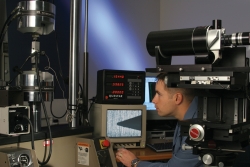Abrasion Testing
Accelerated Life Testing
Chemistry Laboratory
Computer Modeling
Salt Spray Testing
Density
Electrical Properties
Electron Microscopy
Experimental Foundry
Failure Analysis
Hardness Laboratory
Heat Treatment Studies
Light Microscopy
Lubrication Testing
Machine Shop
Materials Databases
Mechanical Testing
Metallography
Paint & Coatings
Product Testing
Rolling Mill
Thermal Testing
Light Microscopy
There was a time when light microscopy implied bright field microscopy and, perhaps, darkfield microscopy. Today, a well-equipped light microscopy facility such as Touchstone has numerous light microscopes capable of a wide variety of imaging systems – most equipped with computerized image analysis systems.
Among the microscopes available to the Touchstone personnel are:
Metallographs and Petrographs
These microscopes have a range of magnifications from 25X to 2000X although 1000X is generally the practical upper limit. Imaging methods include brightfield microscopy, darkfield microscopy, Nomarski interference, oblique illumination and polarized light microscopy. Transparent and translucent samples can be viewed in both the reflected and transmitted light. Photographs can be produced either by film or digitally. Various image analysis systems are available on all these light microscopes.
Long Distance Light Microscope
This Questar microscope is capable of imaging to a magnification of 1000X at a distance of more than a foot away with a resolution of about 1 micron. This remarkable instrument looks more like a telescope than a light microscope. It is equipped with a video output, sits on a tripod and is capable of making precise linear measurements on a surface. It is commonly used in mechanical testing to measure crack growth in various fatigue tests.
Stereo Microscopes
With magnification ranges from 4 to 64X, these microscopes possesses true stereo vision and a large depth of focus. They are primarily used for low power viewing of a wide variety of samples. Lighting is very important with these instruments and to that end, Touchstone is equipped with both standard ring lamps and various fiber optic cable systems for oblique illumination. The microscopes can be set up for color or black and white photography, as well as image analysis and digital image photography.
.jpg)


